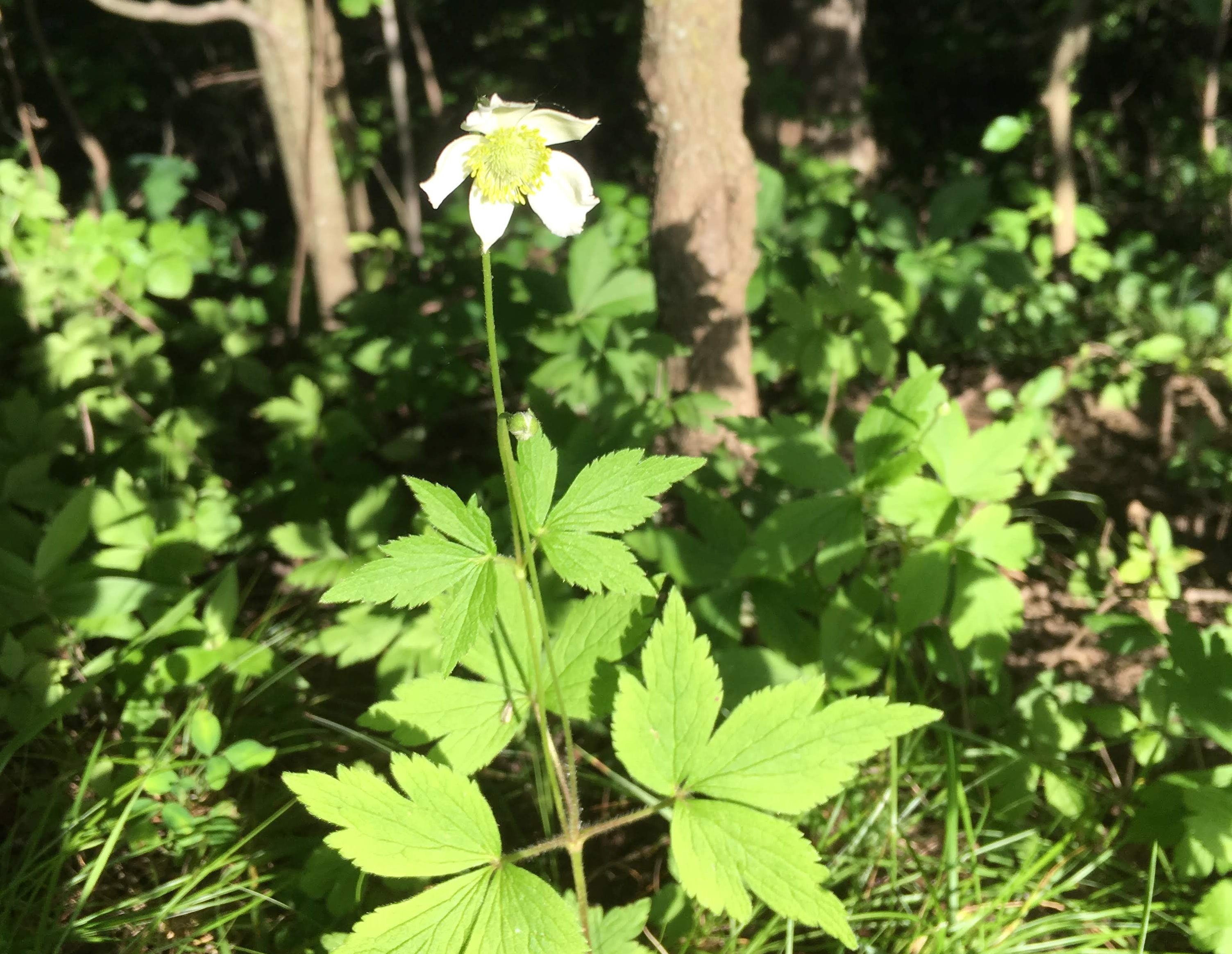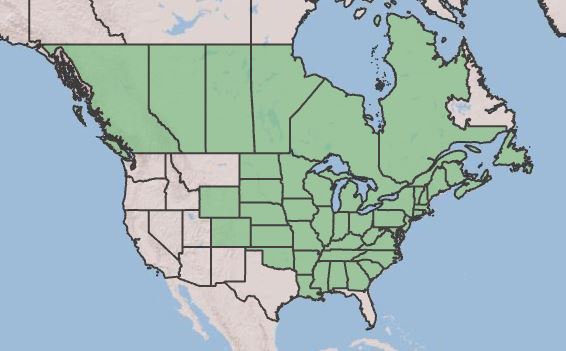Difference between revisions of "Anemone virginiana"
(→Description) |
(→Distribution) |
||
| Line 24: | Line 24: | ||
<!-- Basic life history facts such as annual/perrenial, monoecious/dioecious, root morphology, seed type, etc. -->''Anemone virginiana'' (common name Thimbleweed or Tall Anemone) is a perennial wildflower in the buttercup family, Ranunculaceae, with a bloom period from May to August and a height of 1-3 feet. "Erect perennial found in rich forests and rocky woodlands, especially on circumneutral soils. Stems solitary, loosely hairy. Leaves basal, and 1-2 whorls of similarly shaped leaves toward top of stem, below the flower scapes; palmately divided into 3- (sometimes 5-) parted, toothed, lance-shaped and hairy segments with purple stalks. Flowers solitary on 2 or more hairy, terminal scapes, white, to 1 1/2 in. wide, with give petal-like sepals encircling a green, bristly, cone-shaped compound ovary and ring of bushy stamens. Fruit a thimble-shaped cluster of brownish achenes." <ref> Cotterman, Laura Mansberg, et al. Wildflowers of the Atlantic Southeast. Timber Press, 2019.</ref> | <!-- Basic life history facts such as annual/perrenial, monoecious/dioecious, root morphology, seed type, etc. -->''Anemone virginiana'' (common name Thimbleweed or Tall Anemone) is a perennial wildflower in the buttercup family, Ranunculaceae, with a bloom period from May to August and a height of 1-3 feet. "Erect perennial found in rich forests and rocky woodlands, especially on circumneutral soils. Stems solitary, loosely hairy. Leaves basal, and 1-2 whorls of similarly shaped leaves toward top of stem, below the flower scapes; palmately divided into 3- (sometimes 5-) parted, toothed, lance-shaped and hairy segments with purple stalks. Flowers solitary on 2 or more hairy, terminal scapes, white, to 1 1/2 in. wide, with give petal-like sepals encircling a green, bristly, cone-shaped compound ovary and ring of bushy stamens. Fruit a thimble-shaped cluster of brownish achenes." <ref> Cotterman, Laura Mansberg, et al. Wildflowers of the Atlantic Southeast. Timber Press, 2019.</ref> | ||
| − | ==Distribution== | + | ==Distribution== ""Anemone virginiana'' is widely distributed throughout the eastern United States and the Midwest, in dry to mesic forests, rocky woodlands, barrens, old fields, and clearings, mainly on moderately to strongly base-rich soils. While common in the mountains and Piedmont, it is infrequent in the Coastal Plain. <ref> Weakley, A. S., Ludwig, J. C., Townsend, J. F., & Crowder, B. (2012). Flora of Virginia. Fort Worth, Tex: Botanical Research Institute of Texas Press. </ref> When it occurs in the Coastal Plain, ''Anemone virginiana'' is typically found in calcium-rich habitats. <ref> Hill, Steven R. “Calciphiles and Calcareous Habitats of South Carolina.” Castanea, vol. 57, no. 1, 1992, pp. 25–33. JSTOR, http://www.jstor.org/stable/4033847. Accessed 21 May 2022.</ref> |
| + | |||
==Ecology== | ==Ecology== | ||
<!--===Habitat===--> <!--Natural communities, human disturbed habitats, topography, hydrology, soils, light, fire regime requirements for removal of competition, etc.--> | <!--===Habitat===--> <!--Natural communities, human disturbed habitats, topography, hydrology, soils, light, fire regime requirements for removal of competition, etc.--> | ||
Revision as of 22:07, 20 May 2022
| Anemone virginiana | |
|---|---|

| |
| Photo by Jenny Meyer | |
| Scientific classification | |
| Kingdom: | Plantae |
| Division: | Magnoliophyta - Flowering plants |
| Class: | Magnoliopsida - Dicots |
| Order: | Ranunculales |
| Family: | Ranunculaceae |
| Genus: | Anemone |
| Species: | A. virginiana |
| Binomial name | |
| Anemone virginiana L. | |

| |
| Natural range of Anemone virginiana from USDA NRCS Plants Database. | |
Contents
Taxonomic Notes
Varieties: Anemone virginiana Linnaeus var. virginiana.[1] ranges throughout the southeast. Weakley states that a more northern variety, Anemone virginiana Linnaeus var. alba (Oakes) Alph. Wood., "might be expected in n. VA, especially in river scour situations," but the Flora of Virginia does not list var. alba.[2]
Description
Anemone virginiana (common name Thimbleweed or Tall Anemone) is a perennial wildflower in the buttercup family, Ranunculaceae, with a bloom period from May to August and a height of 1-3 feet. "Erect perennial found in rich forests and rocky woodlands, especially on circumneutral soils. Stems solitary, loosely hairy. Leaves basal, and 1-2 whorls of similarly shaped leaves toward top of stem, below the flower scapes; palmately divided into 3- (sometimes 5-) parted, toothed, lance-shaped and hairy segments with purple stalks. Flowers solitary on 2 or more hairy, terminal scapes, white, to 1 1/2 in. wide, with give petal-like sepals encircling a green, bristly, cone-shaped compound ovary and ring of bushy stamens. Fruit a thimble-shaped cluster of brownish achenes." [3]
==Distribution== ""Anemone virginiana is widely distributed throughout the eastern United States and the Midwest, in dry to mesic forests, rocky woodlands, barrens, old fields, and clearings, mainly on moderately to strongly base-rich soils. While common in the mountains and Piedmont, it is infrequent in the Coastal Plain. [4] When it occurs in the Coastal Plain, Anemone virginiana is typically found in calcium-rich habitats. [5]
Ecology
Conservation, cultivation, and restoration
Cultural use
Photo Gallery
References and notes
- ↑ Flora of the Southern and Mid-Atlantic States by Alan S. Weakley and the Southeastern Flora Team, Edition of April 13, 2022, [1]
- ↑ Virginia Botanical Associates. (2022). Digital Atlas of the Virginia Flora [2]. c/o Virginia Botanical Associates, Blacksburg.
- ↑ Cotterman, Laura Mansberg, et al. Wildflowers of the Atlantic Southeast. Timber Press, 2019.
- ↑ Weakley, A. S., Ludwig, J. C., Townsend, J. F., & Crowder, B. (2012). Flora of Virginia. Fort Worth, Tex: Botanical Research Institute of Texas Press.
- ↑ Hill, Steven R. “Calciphiles and Calcareous Habitats of South Carolina.” Castanea, vol. 57, no. 1, 1992, pp. 25–33. JSTOR, http://www.jstor.org/stable/4033847. Accessed 21 May 2022.